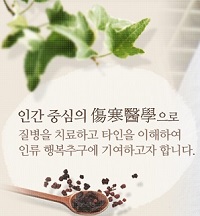『傷寒論』 辨病診斷體系에 근거하여 甘草乾薑湯 복용 후 호전된 인두 이물감 증례 2례
2 case reports of Globus pharyngeus treated by Gamchogungang-tang based on Shanghanlun disease pattern identification diagnostic system
Abstract
Objective : The purpose of this study was to report the improvements of patients with globus pharyngeus treated with herbal medication from Shanghanlun. Methods : Each patient was diagnosed with Greater-yang disease 29th provision of Shanghanlun, and Gamchogungang-tang was used to treat. The result was evaluated by Glasgow-Edinburgh Throat Scale(GETS). Results : The GETS score decreased from 23 to 4 after 40 days of administration in case 1 and from 31 to 1 after 15 days of administration in case 2. Conclusions : Globus pharyngeus improved in each case. This case report suggests that ‘急’ based on the 29th provision of Shanghanlun, can be a direct psychological cause of globus pharyngeus.
- keywords
- Gamchogungang-tang, Globus pharyngeus, Shanghanlun
참고문헌
1. Belafsky PC. Globus. Editorial comment. Curr Opin Otolaryngol Head Neck Surg. 2008;16:497.
2. JOO YH. Globus Pharyngeus:The Psychiatric Perspective. Journal of The Korean Society of Laryngology. Phoniatrics and Logopedics. 2016;27(2):84-6.
3. Lim RC, Roh SS. Review of literature about globus hystericus. J. of the Korean Medical Association. 1989;10(1):249-55.
4. Kim EH and Park JH. A Study on Building a Database of Prescription and Herbs on the Shanghanron. J. of East-West medicine. 2010;35(4):17-23.
5. Park KM and Choi SH. The comparative study of 『Sanghanron』and『hwangjenaegyeong』through historical study on 『Gangpyung·Sanghanron 』. J. of Korean Medical Classics. 1995;9:263-300.
6. Lee SJ and Lim JE. A diagnostic system and clinical application based on <Shanghanlun> six meridian patterns and provisions. Seoul:KMediACs publishing house. 2013.
7. Rho YB, Lee JH, Ha HI. The Fundamental Meaning of Mai and Shanghanlun Provisions Based on Paleography. Seoul:KMediACs publishing house. 2015;7(1):1-14.
8. KIM YM, et al. postperative Adhesion after Thyroid Surgery. Korean J Endocr Surg. 2016;16:94-9.
9. Lee SI. Comparison of Shanghanlun. Seoul:KMediACs publishing house. 2015:195.
10. Shim YJ, et al. Esophageal Air in Patients with Globus Pharyngeus. J Korean Soc Laryngol Phoniatr Logop, 2015;26(2):127-9.
11. Lee HW, Chang YJ, Hong SU. A case of Globus Hystericus caused by psychological, digestive disorder. Journal of Korean Medical Opthalmology &Otolaryngology & Dermatology. 2013;26(2):88-97.
12. Hwang EY et al. A case report of Conversion Disorder Patient with Globus Hystericus and Swallowing difficulty. J. of Oriental Neuropsychiatry. 2009;20(2):197-205.
14. Lee RC and Min JH. A Case Report of Overactive Bladder treated by Gamchogungang-tang, Hoiyeok-tang based on Shanghanlun provision. Seou l:KMediACs publishing house. 2013;5(1):45-52.
15. Ha YS. Etymology Dictionary of Chinese Characters. Pusan:Doseochulpan3. 2015:110-1.
- 다운로드 수
- 조회수
- 0KCI 피인용수
- 0WOS 피인용수


